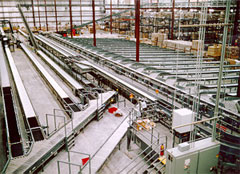Gilmore: Some companies worry that a sortation system won’t be flexible enough to meet future needs, as conditions change. What are the keys to designing a system that has enough flexibility?
Holste: There are several types of sorters available covering a wide range of incremental capacities. Before selecting a sorter, determine what your current capacity requirements are, then add for growth. The sorter may run initially at a rate well below its maximum design speed and then be increased as throughput demands rise. A typical sorter, operating single shift with normal preventative maintenance, will last 10 to 15 years, and even then it can be refurbished and/or reused in a new location.
You have to be sure that the system layout allows for expansion to the picking system (by increasing the picking locations and/or number of pick modules) and the shipping system (by adding more sort locations). However, special attention needs to be given to the location of the sorter induction area, as this is often the most complex part of the system and its location should be considered permanent.
Understand how changes in products, SKU mix, order profiles, and customer demands for value added services will affect the future system operations. Have a plan or strategy worked out for dealing with them before finalizing the system layout.
 Gilmore: I know it varies, but at a high level, what sort of throughput improvements do companies typically achieve when moving to automated sortation? Gilmore: I know it varies, but at a high level, what sort of throughput improvements do companies typically achieve when moving to automated sortation?
Holste: If a non-automated distribution center is picking and shipping 10,000 cases in 8 hours, which is about the minimum required to justify automatic sortation, and they install even the lowest level pop-up belt sorter, they can expect a yield of 20,000 cases in 8 hours. The next step-up in automated sorter capacity will get you into the 40-50,000 case range. My best guess is that an increase in throughput capacity of 2 to 3 times would be typical while providing a reasonable ROI.
Gilmore: If you had to offer a few words of advice for companies investigating whether sortation was right for them, what would it be?
Holste: The quality of sorting equipment, scanners, PC/PLC controls, and conveyor system design being offered today is at its highest level. It’s rare to hear a horror story anymore. Standardization of equipment design and decades of industry experience have virtually eliminated trial and error methods.
No matter how unique and specialized your operation may be, the chances are very good that there is a company (probably a competitor) doing something very similar and already enjoying the benefits of automated sorting. That being said, there is no “one-size-fits-all,” or “out-of-the-box” approach to sorting system design. The proper, most cost effective system solution for your operation will evolve from a thorough analysis of your business data and specific distribution requirements. Shortcutting this crucial planning process may result in not being able to receive the full potential from your investment.
Do you have sortation system experience? What would you add to Holste’s advice? Let us know your thoughts at the Feedback button below. |